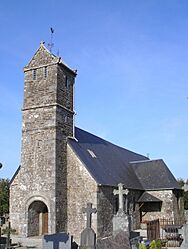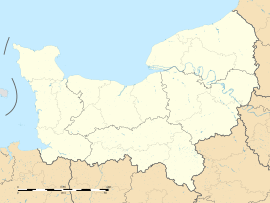Fontenermont facts for kids
Quick facts for kids
Fontenermont
|
|
|---|---|
|
Part of Noues de Sienne
|
|
 |
|
| Country | France |
| Region | Normandy |
| Department | Calvados |
| Arrondissement | Vire |
| Canton | Vire Normandie |
| Commune | Noues de Sienne |
| Area
1
|
2.79 km2 (1.08 sq mi) |
| Population
(2019)
|
148 |
| • Density | 53.05/km2 (137.4/sq mi) |
| Time zone | UTC+01:00 (CET) |
| • Summer (DST) | UTC+02:00 (CEST) |
| Postal code |
14380
|
| Elevation | 170–265 m (558–869 ft) (avg. 200 m or 660 ft) |
| 1 French Land Register data, which excludes lakes, ponds, glaciers > 1 km2 (0.386 sq mi or 247 acres) and river estuaries. | |
Fontenermont was once a small commune in northwestern France. It was located in the Calvados department, which is part of the Normandy region. Think of a commune like a small town or village with its own local government.
On January 1, 2017, Fontenermont joined with several other nearby communes. They all merged together to form a new, larger commune called Noues de Sienne. This happens sometimes when smaller towns decide to combine their resources.
Contents
What is a French Commune?
In France, a commune is the smallest unit of local government. It's like a city, town, or village. Each commune has a mayor and a local council. They manage things like schools, roads, and local services.
Why Communes Merge
Communes sometimes merge for several reasons. One big reason is to share resources and save money. Smaller communes might not have enough people or funds for certain services. By merging, they can combine their budgets and offer better services. This can include things like better schools, libraries, or sports facilities. Merging can also make local government more efficient.
Where is Fontenermont Located?
Fontenermont is found in the Calvados department. This department is in the Normandy region of France. Normandy is famous for its beautiful countryside and rich history. It is in the northwestern part of France.
Population Changes in Fontenermont
The number of people living in Fontenermont changed over the years. Here's a quick look at its population history:
- 1962: 176 people
- 1968: 161 people
- 1975: 145 people
- 1982: 139 people
- 1990: 126 people
- 1999: 140 people
- 2008: 143 people
- 2019: 148 people (just before it merged)
As you can see, the population slowly decreased for a while. Then, it started to grow a little bit again before the merger. Population numbers help us understand how a place changes over time.
See also
 In Spanish: Fontenermont para niños
In Spanish: Fontenermont para niños




